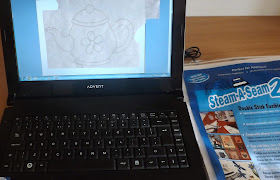Sew your own appliqued tea cosy
A dear friend of ours is unwell at the moment, so I really wanted to make her a gift which would demonstrate how much both she and her husband are loved. She lives in a university town and has helped tens and tens of students to feel a little less homesick. She also gives countless hours of her time to the local community and her church as well as supporting many charities!
As soon as a visitor walks through the door of her home the kettle is on and so the obvious thing to make her was........
A personalised tea cosy
and here's how it's done.....
Firstly collect together some heavy weight material for the main body of the cosy and some wadding/batting for the insulation layer. I used an old cushion as my main material as this was a nice heavy furnishing fabric. You can use a thinner dress-making material, but this would just not be as cosy!
For the wadding I used the backing from an old ironing board cover, as it's good to be green and upcycle wherever possible! I then free-motion quilted the two layers together; in the picture I have folded the fabric back over as the quilting is very subtle on the right side and it can be seen better from the back.
Next I drew a simple tea-cosy pattern onto a sheet of A3 paper. I then drew around this straight onto the front of my fabric. I find this the easiest way of doing things, as I can then insure that all the applique pieces are central. Should any of them 'walk' during the making process I can simply retrace the pattern before actually cutting out the item. I use a 'friction' pen to do this. They are sold in most supermarkets and stationers and are really meant to be used on paper and when you rub the writing with the pen lid, the heat this friction creates causes the ink to disappear. When used on fabric simply use an iron and, hey presto, the marks have gone!
Now draw yourself a suitable design for the applique. Or, if like me art is not your strong point, find an image on Google. Your picture then needs to be traced onto your fusible web. I generally use bondaweb as it is quite cheap, but today I am using a pack of steam-a-seam which I picked up in a sale.
I don't bother printing out the picture, I merely trace it straight onto the fusible web from my laptop;
Don't forget that when using fusible web the image needs to be flipped. Now I'm not sure how to flip text on the computer so that it is a mirror image. So I simply used tracing paper on the laptop screen to copy the writing and then turned the tracing paper over and put that underneath the bondaweb/steam-a-seam.
Look carefully at the following picture and you will see the reversed text waiting to be applied to its fabric.
Lay out all of your pieces and once you are happy with the design, iron to fix it. You are now ready to stitch the applique into place. I used an open-toe applique foot and a reduced stitch length;
If your machine allows you to stop with the needle down this will make turning corners much easier. Simply stop, leave the needle in, raise the foot, pivot the fabric, drop the foot and resume stitching.
If you prefer, you can also use a darning foot, drop the feed dog and free-motion quilt around the pieces. Once all the stitching has been completed check that the design is central, and if happy cut out;
Then pin or tack a tab at the top of the cosy;
Okay, almost there!
Place the front and back of the cosy right sides together and stitch. Turn right side out and press. Now chose a lining fabric. This can be a lighter weight than the cosy iteslf. I chose a lovely cupcake design.
Use your paper pattern to cut two lining pieces. Swing your sewing machine needle over to the left so that the lining will be ever so slightly smaller than the cover. Do not forget to leave a gap in the seam so that you can turn the cosy right side out at the end!
Now pin the cosy and lining right side together and stitch along the bottom. Turn it through the gap in your lining so that it is now right sides out. Hand stitch the opening closed. I then top-stitched the cosy a couple of centimetres up from the bottom so that the lining was nice and secure and that's it.........












I love your tea cosy! The raw edge applique is just beautiful.
ReplyDelete